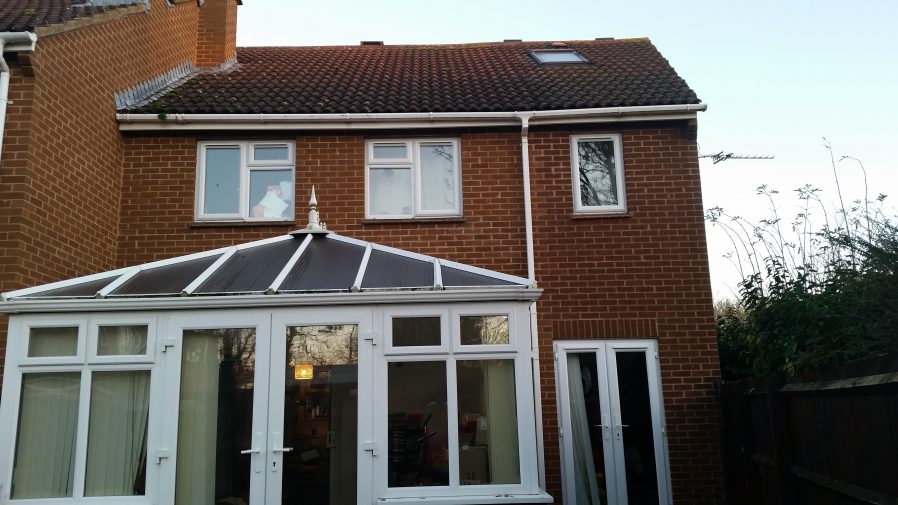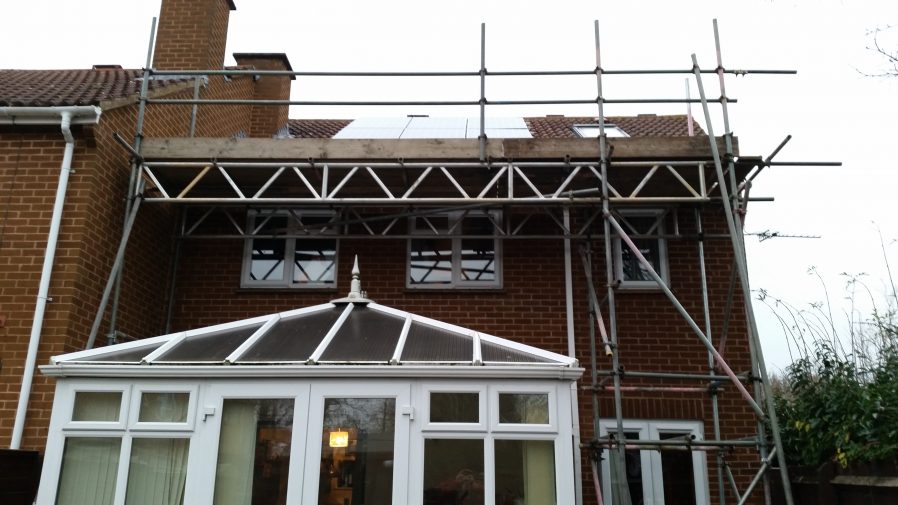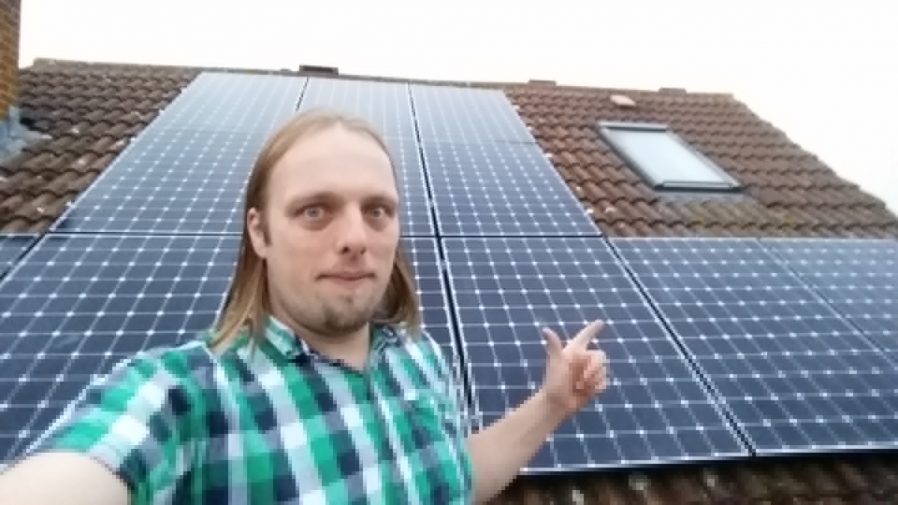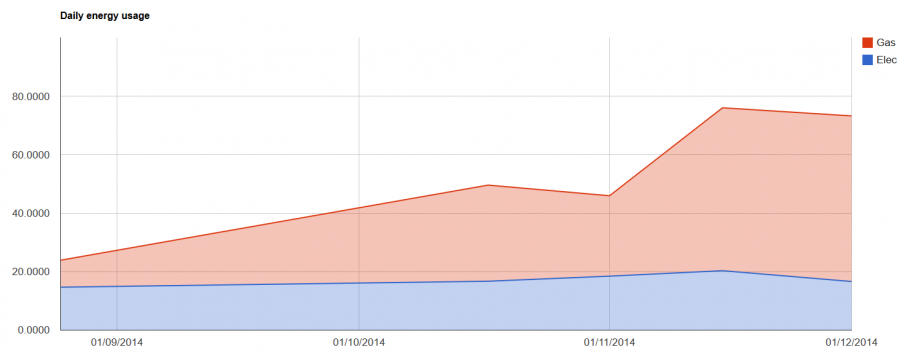One of the great joys of owning a house is that you can do pretty much whatever you please with it. I celebrated Ruth, JTA and I’s purchase of Greendale last year by wall-mounting not one but two televisions and putting shelves up everywhere. But honestly, a little bit of DIY isn’t that unusual nor special. We’ve got plans for a few other changes to the house, but right now we’re pushing our eco-credentials: we had cavity wall insulation added to the older parts of the building the other week and an electric car charging port added not long before that. And then… came this week’s big change.

Solar photovoltaics! They’re cool, they’re (becoming) economical, and we’ve got this big roof that faces almost due-South that would otherwise be just sitting there catching rain. Why not show off our green credentials and save ourselves some money by covering it with solar cells, we thought.

Because it’s me, I ended up speaking to five different companies and, after removing one from the running for employing a snake for a salesman, collecting seven quotes from the remaining four, I began to do my own research. The sheer variety of panels, inverters, layouts and configurations (all of which are described in their technical sheets using terms that in turn required a little research into electrical efficiency and dusting off formulas I’d barely used since my physics GCSE exam) are mind-boggling. Monolithic, string, or micro-inverters? 250w or 327w panels? Where to run the cables that connect the inverter (in the attic) to the generation meter and fusebox (in the ground floor toilet)? Needless to say, every company had a different idea about the “best way” to do it – sometimes subtly different, sometimes dramatically – and had a clear agenda to push. So – as somebody not suckered in to a quick deal – I went and did the background reading first.

In case you’re not yet aware, let me tell you the three reasons that solar panels are a great idea, economically-speaking. Firstly, of course, they make electricity out of sunlight which you can then use: that’s pretty cool. With good discipline and a monitoring tool either in hardware or software, you can discover the times that you’re making more power than you’re using, and use that moment to run the dishwasher or washing machine or car charger or whatever. Or the tumble drier, I suppose, although if you’re using the tumble drier because it’s sunny then you lose a couple of your ‘green points’ right there. So yeah: free energy is a nice selling point.
The second point is that the grid will buy the energy you make but don’t use. That’s pretty cool, too – if it’s a sunny day but there’s nobody in the house, then our electricity meter will run backwards: we’re selling power back to the grid for consumption by our neighbours. Your energy provider pays you for that, although they only pay you about a third of what you pay them to get the energy back again if you need it later, so it’s always more-efficient to use the power (if you’ve genuinely got something to use it for, like ad-hoc bitcoin mining or something) than to sell it. That said, it’s still “free money”, so you needn’t complain too much.
The third way that solar panels make economic sense is still one of the most-exciting, though. In order to enhance uptake of solar power and thus improve the chance that we hit the carbon emission reduction targets that Britain committed to at the Kyoto Protocol (and thus avoid a multi-billion-pound fine), the government subsidises renewable microgeneration plants. If you install solar panels on your house before the end of this year (when the subsidy is set to decrease) the government will pay you 14.38p per unit of electricity you produce… whether you use it or whether you sell it. That rate is retail price index linked and guaranteed for 20 years, and as a result residential solar installations invariably “pay for themselves” within that period, making them a logical investment for anybody who’s got a suitable roof and who otherwise has the money just sitting around. (If you don’t have the cash to hand, it might be worth taking out a loan to pay for solar panels, but then the maths gets a lot more complicated.)

The scaffolding went up on the afternoon of day one, and I took the opportunity to climb up myself and give the gutters a good cleaning-out, because it’s a lot easier to do that from a fixed platform than it is from our wobbly “community ladder”. On day two, a team of electricians and a solar expert appeared at breakfast time and by 3pm they were gone, leaving behind a fully-functional solar array. On day three, we were promised that the scaffolding company would reappear and remove the climbing frame from our garden, but it’s now dark and they’ve not been seen yet, which isn’t ideal but isn’t the end of the world either: not least because Ruth’s been unwell and thus hasn’t had the chance to get up and see the view from the top of it, yet.

We made about 4 units of electricity on our first day, which didn’t seem bad for an overcast afternoon about a fortnight away from the shortest day of the year. That’s about enough to power every light bulb in the house for the duration that the sun was in the sky, plus a little extra (we didn’t opt to commemorate the occasion by leaving the fridge door open in order to ensure that we used every scrap of the power we generated).
Because I’m a bit of a data nerd these years, I’ve been monitoring our energy usage lately anyway and as a result I’ve got an interesting baseline against which to compare the effectiveness of this new addition. And because there’s no point in being a data nerd if you don’t get to share the data love, I will of course be telling you all about it as soon as I know more.
Nice one :) If I can ever afford somewhere nice around here I’d love to have a hyrdopower installation. There’s already a few around the valley including one I often walk past on the way into Hebden.